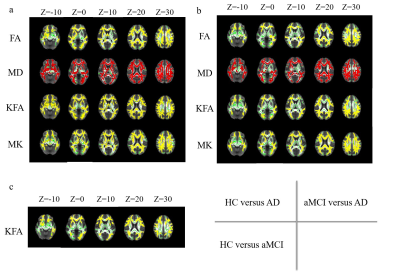Tongtong Li1, Yu Zhang1, Xiuwei Fu2, Xianchang Zhang3, Yuan Luo4, and Hongyan Ni5
1First Central Clinical College, Tianjin Medical University, Tianjin, China, 2Tianjin Medical University General Hospital, Tianjin, China, 3MR Collaboration, Siemens Healthcare Ltd, Beijing, China, 4Department of Radiology, China-Japan Friendship Hospital, Beijing, China, 5Department of Radiology, Tianjin First Central Hospital, Tianjin, China
1First Central Clinical College, Tianjin Medical University, Tianjin, China, 2Tianjin Medical University General Hospital, Tianjin, China, 3MR Collaboration, Siemens Healthcare Ltd, Beijing, China, 4Department of Radiology, China-Japan Friendship Hospital, Beijing, China, 5Department of Radiology, Tianjin First Central Hospital, Tianjin, China
This study found
kurtosis fractional anisotropy values outperformed other DKI-derived parameters
in sensitive detection of microstructural white matter damage for early
diagnosis of amnestic mild cognitive impairment and Alzheimer's disease.

Figure
1. Comparison results of different DKI-derived parameters between HC and AD,
aMCI and AD, and HC and aMCI, respectively. Green represents the FA skeleton
overlaid on the FMRIB58_FA template. Yellow indicates the brain structures with
significantly decreased parameter values in the aMCI and AD groups (p<0.01,
TFCE-corrected). Red indicates the brain structures with significantly
increased parameter values in the aMCI and AD groups (p<0.01,
TFCE-corrected)
